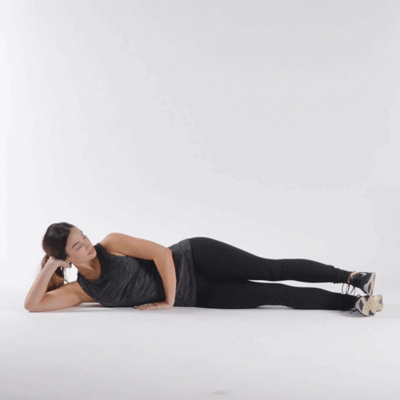Exercises you perform prior to knee replacement surgery can strengthen your knee, improve flexibility, and help you recover faster. There are numerous exercises you can do at home. But it’s important to speak to your surgeon and physical therapist before you start any new exercise regimen.
Jamie Nelson, PT, DPT, offers insights into how you can strengthen your muscles before surgery. Doing these exercises will allow rehab to go more quickly and effectively.
Begin with five to 10 repetitions of each exercise twice a day the first week, then increase to 10 to 15 repetitions by week two, and finally move up to 15 to 20 repetitions by week three.

This exercise helps build the quadriceps muscle that attaches to the knee.
- Lie on your back.
- Tighten the muscles in the front of your thigh by pushing the back of your knee down toward the floor or bed.
- Hold for 5 seconds and then release.
- Perform up to 3 sets of 5 to 20 repetitions.

This exercise is crucial in building your hip abductor muscles located in the buttocks. These muscles stabilize your pelvis while you are standing and walking.
- Lie on your side.
- Lift your leg straight up toward the ceiling to a distance of about 1 1/2 to 2 feet from your other leg.
- Lower your leg and repeat.
- Perform up to 3 sets of 10.
- Lie on your back and place your problem leg flat on the floor or bed while bending the other leg.
- Raise your straightened leg up about 12 inches and hold it there for 5 seconds.
- Slowly lower your leg.
- Perform up to 3 sets of 5 to 20 repetitions.
These leg raises will help build your quadriceps and hip flexor muscles. This is especially important for regaining movement after surgery.
This works the external rotators and part of your abductors. Both are important for early ambulation and balance.
- Lie on your side with the damaged knee pointed toward the ceiling.
- Keeping your heels together, open and close your legs like a clamshell.
- Perform up to 3 sets of 5 to 20 repetitions.
This helps maintain your range of motion prior to your surgery.
- Sit in a stable chair and bend your knee back as far as possible.
- Hold it for 5 seconds and then return it to the resting position.
- Perform up to 3 sets of 5 to 20 repetitions.
This helps strengthen the quadriceps muscle through its full range of motion.
- Sit in a stable chair and raise your leg until it’s straight.
- Hold the position for 5 seconds.
- Slowly lower your leg.
- Perform up to 3 sets of 5 to 20 repetitions.
This will help strengthen your triceps so they can hold you up when you don’t have the use of both legs after surgery.
- Sit in a sturdy chair with arms.
- Grasp the arms of the chair and push down on them while raising your body and straightening your arms and elbows.
- Slowly lower yourself back onto the chair. This will help strengthen your triceps so they can hold you up when you don’t have the use of both legs after surgery.
Lie on the floor or a bed and place a rolled blanket or large can under your problematic knee. Straighten your leg and the knee and hold the position for 5 seconds. Slowly lower your leg down and rest. Make sure the back of your knee stays in contact with the object the entire time and the small of your back remains on the floor. This exercise also helps strengthen the quadriceps muscle.
This helps strengthen your hamstrings and the gluteal muscles in your butt. These muscles are important for getting in and out of chairs and cars.
- Lie on your stomach with your leg straight and then slowly bring your whole leg toward the ceiling.
- Hold for 2-3 seconds.
- Slowly lower your leg.
This exercise is crucial for maintaining balance and reducing the risk of falls. Perform this exercise as many times as you can per day.
- Place yourself in front of a countertop or waist-level bar.
- Hold onto the bar and stand on your affected leg for 30 seconds.
- Make sure to squeeze your gluteal muscles (in your butt) together to engage your abductors.
Original article and pictures take d3otfkap419ijo.cloudfront.net site
Комментариев нет:
Отправить комментарий